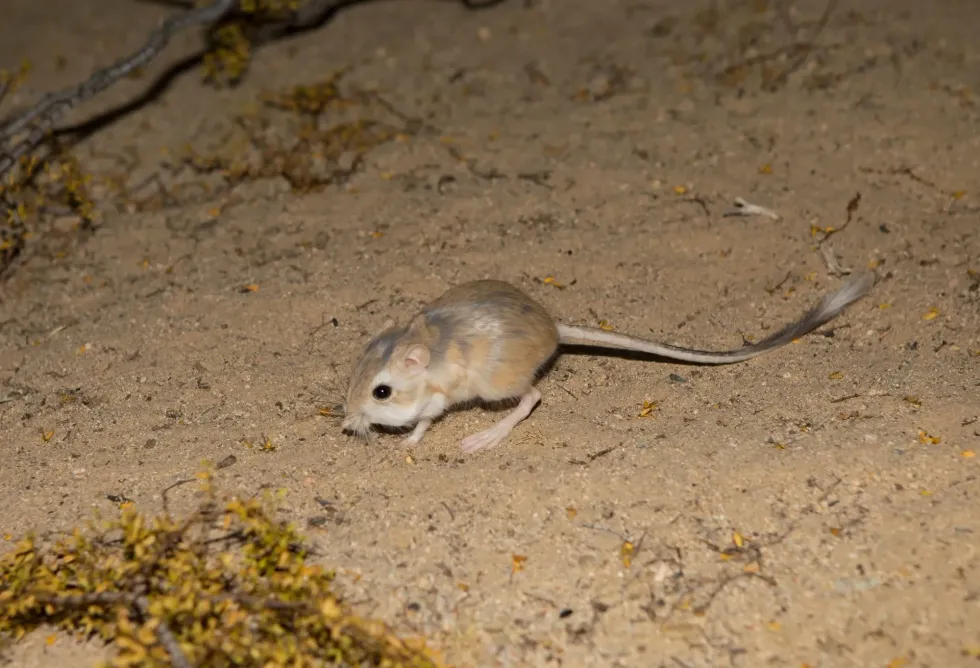One thing that you are sure to find around any household is a rat! These small critters are far more fascinating than their appearance seems to give away.
One such species is the Texas kangaroo rat. This kangaroo rat belongs to one of the 22 types of bipedal North American desert rodents. They are popular for their tufted tails.
These are very rare mammals that are highly vulnerable and have been listed as a threatened species. The Texas kangaroo rat is a nocturnal creature and is most active after the sunsets.
Texas kangaroo rats are known for their big heads and eyes. They have tiny forelimbs, and elongated hind legs and feet. Their big head has cheek pouches on either side, lined with fur, and opens alongside their mouth.
These cheek pouches are used to clean and maintain hygiene. These rodents are borrowing animals, similar to gophers they too are known for digging burrows.
Read on to discover more fun facts about this rodent! For more relatable content, check out these Syrian hamster facts and gopher facts for kids.
Texas Kangaroo Rat Interesting Facts
What type of animal is a Texas kangaroo rat?
The Texas kangaroo rat (Dipodomys elator) is a rodent commonly found in north-central Texas.
What class of animal does a Texas kangaroo rat belong to?
The Texas kangaroo rat (Dipodomys elator) belongs to the class Mammalia.
How many Texas kangaroo rats are there in the world?
We can not accurately predict the precise number of these rats, as have not been properly studied yet. However, Texas kangaroo rats are considered to be a highly threatened species.
Where does a Texas kangaroo rat live?
The distribution of the Texas kangaroo rats (Dipodomys elator) can be found in desert grasslands or mixed grassy scrubland, and woodlands and clay soils all year round. The distribution of the Texas kangaroo rat is primarily in western North America, southern Canada, southern Mexico, and north-central Texas.
The north Texas kangaroo rat territory occurs in north-central Texas from Cottle and Motley counties in the west to Montague County in the east.
What is a Texas kangaroo rat's habitat?
The Texas kangaroo rat's environment consists of well-drained sandy soils or gritty soils. They also prefer regions of open and sparsely vegetated, dry, and hot regions such as chaparral or sagebrush.
These rats are also found in desserts, mixed grasslands, or even juniper woodlands. Texas kangaroo rats (Dipodomys elator) dig up burrows in regions bordering fencerows and pasture roads and around barns, and grain-storage facilities in farms and barns. This rodent is active all year round.
Who do Texas kangaroo rats live with?
These rats are considered to be solitary rodents, which means that they live on their own in their burrow. They are usually found in short grasses and scattered mesquite bushes and their burrows.
How long does a Texas kangaroo rat live?
The life span of these rodents ranges from one to two years under natural conditions and suitable habitats. However, the Texas Parks and Wildlife Department has recorded a life span of longer than three years in an artificial habitat.
How do they reproduce?
Texas kangaroo rats usually reproduce in late summer, which is followed by torrential rainfall. The female rat will make sure there is enough food stored during the period of breeding.
This rodent usually assesses its surroundings and adjusts to its breeding environment based on the existing conditions. These species prefer to breed between February and May and produce only two or three litters every year in late spring or summer. Before mating, the male and female will sniff around until the female permits the breeding process to begin.
The young newborns are usually fur-lined and are laid into the nests in the burrow. They are born blind with soft pink skin and no fur. In the first week, these young rats crawl around the burrow and develop their hind legs.
They eventually become independent young ones. The status of their incubation period is unknown.
What is their conservation status?
The Texas Parks and Wildlife Department has marked their conservation status as Vulnerable and a highly threatened species. These species are threatened as a result of the limited geographic range and habitat alteration for agricultural purposes, making them quite rare.
Texas Kangaroo Rat Fun Facts
What do Texas kangaroo rats look like?

Texas kangaroo rats are known for their big heads and eyes. They have tiny forelimbs, and elongated hind legs and feet.
Their big head has cheek pouches of this species on either side, lined with fur and open alongside the mouth. These cheek pouches are used to clean and maintain hygiene.
The Texas kangaroo rat tail is lengthy and accounts for more than half of its total length. These mammals of Texas are covered in soft and silky fur that is dense, and ranges in color from sandy to buff to dark brown.
These species have prominent white facial markings with one white stripe on each hip and white underneath their belly fur. The hairy, elongated tail bears a sharp white or brown tuft.
How cute are they?
Texas kangaroo rats (Dipodomys elator) are quite adorable to look at. These have long hind legs which they use to hop around, this adds to their cute appearance. The Texas kangaroo rat eating is one of the cutest images.
How do they communicate?
Texas kangaroo rats (Dipodomys elator) are known to be a rare, nocturnal, and antisocial mammal of Texas. Because of this kind of behavior, it is hard to study their means of communication.
However, Texas kangaroo rats have been spotted make thumping sounds upon entering a burrow. These rodents are known to have sharp vision and hearing and these likely pave way for communication. Also, tactile communication is seen in territorial conflicts, between the female and male rats, and between mothers and their babies.
How big is a Texas kangaroo rat?
The Texas kangaroo rat is 4-8 in (10-20.3 cm) in length. This animal is considered to be a light to a very lightweight animal. They are smaller than muskrats.
How fast can a Texas kangaroo rat run?
The Texas kangaroo rat can spring across a distance of 7-9 ft (2.1-2.7 m) These tiny critters are quite swift and can cover a distance at 6.2 mph (10 kph). They can quickly and rightly change direction between each leap as they have a long eyesight range. They have been spotted running around quite frequently in the late summertime.
How much does a Texas kangaroo rat weigh?
The Texas kangaroo rat weighs 1.2-6.3 oz (35-180 g) on average. It is rare for this animal to weigh more than this. These rodents are ten times smaller than the pouched rat and almost as big as the rice rats.
What are the male and female names of the species?
While there is no specific name for these kangaroo rats, male rats are called bucks, and females are called does.
What would you call a baby Texas kangaroo rat?
Baby kangaroo rats or infants are called pups or kittens.
What do they eat?
The Texas kangaroo rat diet consists of forbs, leaves of stems, short grasses, leaves of grasses, perennials, seeds, stems, mesquite, and various other types of plant material. Their diet is limited to leafy greens as food.
Are they dangerous?
No, the Texas kangaroo rat is a harmless creature. Although rats are considered to be quite aggressive, the kangaroo rat is quite calm. These rats are nocturnal in nature and are most active after dusk.
Would they make a good pet?
These species are not the ideal pet that humans would prefer to have as these creatures are desert creatures and require a very specific ideal environment condition. In most places, it is considered illegal to own one of these kangaroo rat texas; rodents as a pet.
You need permission from the Texas Parks and Wildlife Department in order to own one of these as a pet. However, several Texas kangaroo rat stores do operate in regions where it is legal to have these species as pets.
Did you know...
The coat of the Texas kangaroo rat is replaced annually at different points of time during the year based on the maturity of the rat.
Since the habitat of a kangaroo rat is hot and dry, they have to conserve water. This is why the Texas kangaroo rat obtains enough water from the metabolic oxidation of the seeds from plants that they consume to survive and do not need to drink water at all.
The Texas parks and wildlife department plays a huge role in taking care of this habitat.
The North Texas kangaroo rats territory is the largest territory of these species. The range of Texas kangaroo rats is very large and is one of the largest for rodents.
The kangaroo rat research in Texas is a very famous research study topic. Owning a texas kangaroo rats store is illegal in most regions.
What is special about kangaroo rats?
Texas kangaroo rats hunt only at night as they are nocturnal creatures and transport the food in their cheek pouches to store either in the burrow or in some pits nearby.
The most popular part of these rodents is their tail and the reason behind its popularity is that the tail of this rat is the key reason for its balance.
Why are Texas kangaroo rats endangered?
The Texas kangaroo rat has been petitioned for listing under the Endangered Species Act, which means the status of these animals is critically threatened. The only reason for the vulnerability and danger of these creatures is the fragmented habitat and because their habitual areas are continuing to be degraded and washed off by humans intervention.
These threatened species fall prey to degradation in the continued agricultural expansion done by humans.
Here at Kidadl, we have carefully created lots of interesting family-friendly animal facts for everyone to discover! Learn more about some other mammals from our black rat interesting facts and naked mole-rat fun facts pages.
You can even occupy yourself at home by coloring in one of our free printable texas kangaroo rat coloring pages.









